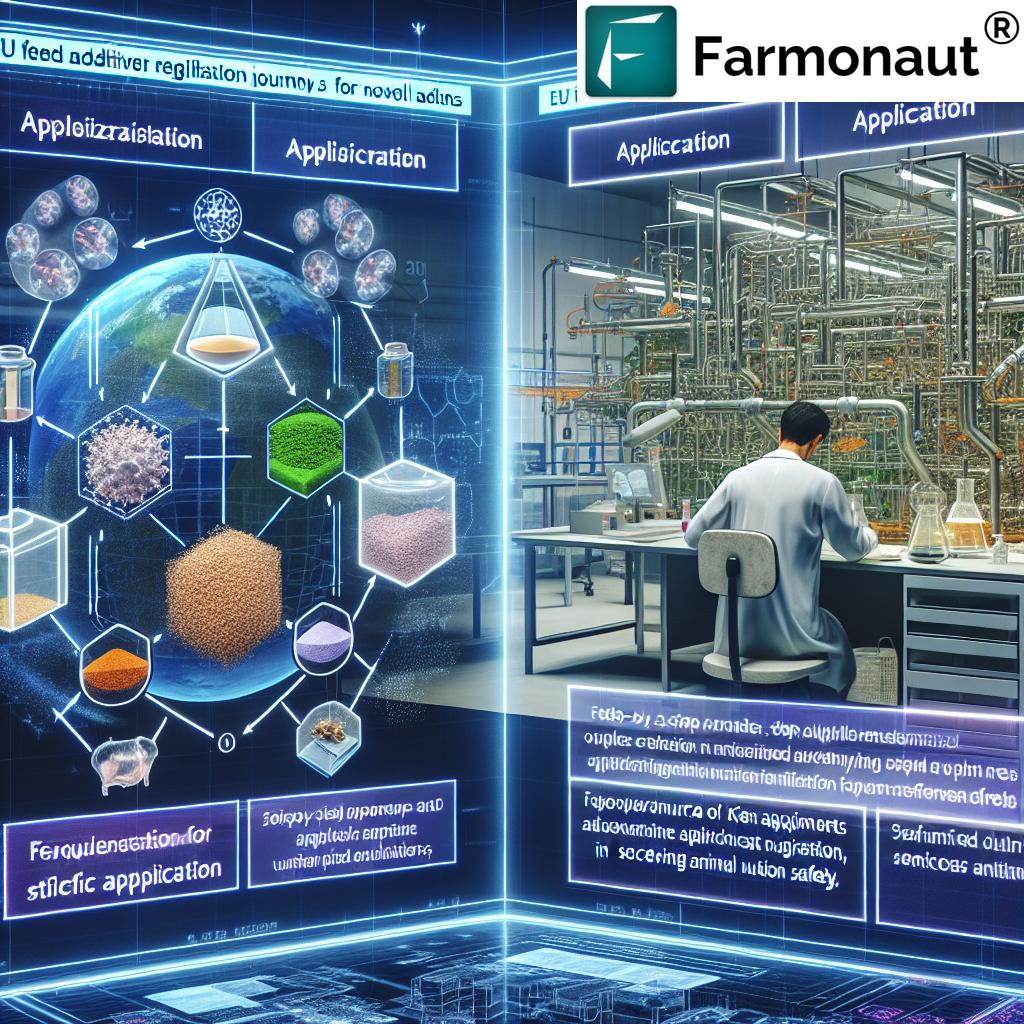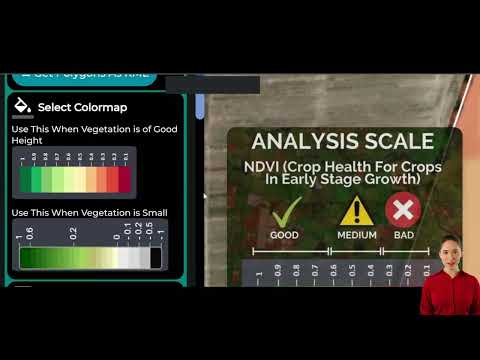Navigating EU Feed Additive Regulations: A Comprehensive Guide to Authorization and Compliance
In the ever-evolving landscape of agricultural technology and animal nutrition, understanding and complying with EU feed additive regulations is crucial for stakeholders in the agribusiness sector. As pioneers in precision agriculture, we at Farmonaut recognize the importance of staying informed about these regulations to ensure the safety and efficacy of animal feed products. This comprehensive guide will navigate you through the intricacies of EU feed authorization processes, providing valuable insights into the complex world of feed additive applications.

“The EU feed additive authorization process involves evaluating over 2,700 additives for safety and efficacy.”
Understanding EU Feed Additive Regulations
The European Union has established a robust regulatory framework to ensure the safety and efficacy of feed additives used in animal nutrition. These regulations are designed to protect animal health, human health, and the environment while promoting fair competition in the feed industry. Let’s delve into the key aspects of EU feed additive regulations:
- Regulation (EC) No 1831/2003: This is the cornerstone of EU feed additive legislation, establishing the procedures for the authorization of feed additives.
- EFSA Guidelines: The European Food Safety Authority (EFSA) provides detailed guidance on the preparation and presentation of applications for feed additive authorizations.
- Commission Implementing Regulation (EU) 2018/1831: This regulation outlines specific rules for the preparation and presentation of applications for authorization or renewal of authorizations of feed additives.
Understanding these regulations is essential for anyone involved in the feed industry, from manufacturers to farmers utilizing precision agriculture tools like those offered by Farmonaut.
The EU Feed Authorization Process: A Step-by-Step Guide
Navigating the EU feed authorization process can be complex, but breaking it down into steps can make it more manageable. Here’s a comprehensive overview of the process:
- Pre-submission Phase: Applicants should thoroughly review EFSA guidance documents and consult with experts to ensure their dossier is complete.
- Dossier Preparation: Compile all necessary technical documentation, including safety data, efficacy studies, and environmental impact assessments.
- Submission: Submit the application to the European Commission, which will forward it to EFSA for scientific assessment.
- Validation: EFSA checks the completeness of the dossier and may request additional information if needed.
- Scientific Assessment: EFSA’s expert panels evaluate the safety and efficacy of the feed additive.
- Opinion Publication: EFSA publishes its scientific opinion, which forms the basis for the Commission’s decision.
- Decision-making: The European Commission prepares a draft regulation for the Standing Committee on Plants, Animals, Food and Feed (SCPAFF) to vote on.
- Authorization: If approved, the feed additive is added to the EU Register of Feed Additives.
This process ensures that only safe and effective feed additives reach the market, contributing to sustainable animal nutrition practices.
Key Requirements for Feed Additive Applications
When preparing a feed additive application, it’s crucial to address the following key requirements:
- Safety Assessment: Provide comprehensive data on the safety of the additive for target animals, consumers, users, and the environment.
- Efficacy Studies: Demonstrate the efficacy of the additive through well-designed scientific studies.
- Quality Control: Outline the manufacturing process and quality control measures to ensure consistent product quality.
- Analytical Methods: Provide validated methods for detecting and quantifying the additive in feed and, where relevant, in animal tissues.
- Post-market Monitoring Plan: Propose a plan for monitoring the additive’s performance and safety after market authorization.
Meeting these requirements demands a thorough understanding of both the regulatory landscape and the scientific principles underlying feed additive use. This is where precision agriculture tools, like those provided by Farmonaut, can play a crucial role in data collection and analysis to support efficacy claims.
Types of Feed Additive Authorizations
The EU regulatory framework recognizes different scenarios for feed additive authorizations. Understanding these is crucial for stakeholders in the agritech and animal nutrition sectors:
| Authorization Type | Application Requirements | Estimated Timeline | Key Considerations |
|---|---|---|---|
| New Feed Additive | Full dossier including safety and efficacy data | 12-18 months | Novel ingredient assessment, extensive safety testing |
| Renewal of Existing Authorization | Updated dossier with new safety data and post-market experience | 6-12 months | Focus on long-term safety and efficacy evidence |
| Re-evaluation of Authorized Additive | Comprehensive review of existing data and new scientific evidence | 12-24 months | Address any emerging safety concerns or new scientific findings |
| Modification of Existing Authorization | Targeted dossier focusing on proposed changes | 3-6 months | Impact assessment of modifications on safety and efficacy |
Each type of authorization has its unique challenges and opportunities. For instance, new feed additives may offer innovative solutions for improving animal nutrition, but they also require the most extensive documentation and longest approval timelines. On the other hand, renewals and modifications can leverage existing data, potentially streamlining the process.
“Approximately 70% of EU feed additive applications require renewal or re-evaluation every 10 years to maintain compliance.”
Preparing a Successful Feed Additive Application
Creating a successful feed additive application requires meticulous planning and execution. Here are some key steps to consider:
- Conduct Thorough Research: Review existing literature and regulatory decisions for similar additives to inform your approach.
- Engage with Experts: Consult with regulatory specialists and scientists experienced in feed additive assessments.
- Plan Comprehensive Studies: Design and execute robust safety and efficacy studies that meet EFSA’s rigorous standards.
- Prepare Clear Documentation: Organize your dossier logically, ensuring all required information is presented clearly and concisely.
- Address Potential Concerns Proactively: Anticipate questions or concerns regulators might have and address them in your application.
By following these steps and leveraging advanced agritech solutions like those offered by Farmonaut, applicants can significantly improve their chances of success in the EU feed authorization process.
Explore Farmonaut’s API for advanced agricultural data analysis
Navigating Technical Documentation Requirements
The technical documentation required for EU feed additive applications is extensive and can be challenging to navigate. Here’s an overview of the key components:
- Administrative Data: Including applicant details, proposed denomination, and classification of the additive.
- Characterization of the Additive: Detailed information on composition, physical-chemical and technological properties, and manufacturing process.
- Safety Studies: Comprehensive data on the safety for target animals, consumers, users, and the environment.
- Efficacy Studies: Evidence demonstrating the additive’s effectiveness for its intended use.
- Post-market Monitoring Plan: Proposals for monitoring the additive’s performance and safety after authorization.
Each of these components requires careful preparation and presentation to meet EFSA’s stringent requirements. Utilizing advanced data management tools and precision agriculture technologies can greatly assist in organizing and analyzing the vast amount of information needed for a successful application.
Access Farmonaut’s API Developer Docs for integration insights
The Role of Sustainability in Feed Additive Regulations
As the global focus on sustainability intensifies, EU feed additive regulations are evolving to incorporate environmental considerations more prominently. This shift aligns with broader EU agricultural policies aimed at promoting sustainable farming practices. Key aspects include:
- Environmental Impact Assessments: Applications must now include more detailed evaluations of the additive’s potential environmental effects.
- Promotion of Circular Economy: Additives derived from by-products or waste streams are gaining favor, aligning with circular economy principles.
- Reduction of Antibiotic Use: There’s an increased focus on additives that can improve animal health and reduce the need for antibiotics.
- Carbon Footprint Considerations: The carbon footprint of feed additive production and use is becoming an important factor in the evaluation process.
These sustainability-focused regulations present both challenges and opportunities for feed additive manufacturers. Companies that can demonstrate the environmental benefits of their products may gain a competitive edge in the authorization process.

Leveraging Technology in Feed Additive Compliance
In the era of digital transformation, technology plays a crucial role in ensuring compliance with EU feed additive regulations. Advanced tools and platforms can streamline the application process and enhance data management. Here’s how technology is making a difference:
- Data Management Systems: Sophisticated software solutions help organize and track the vast amount of data required for feed additive applications.
- Automated Compliance Checks: AI-powered tools can perform preliminary compliance checks, helping identify potential issues early in the application process.
- Real-time Monitoring: IoT devices and sensors can provide real-time data on feed additive performance, supporting post-market surveillance requirements.
- Blockchain for Traceability: Blockchain technology can enhance the traceability of feed additives throughout the supply chain, supporting regulatory compliance.
At Farmonaut, we understand the importance of leveraging technology in agriculture. While our focus is on precision farming and crop monitoring, the principles of data-driven decision-making apply equally to feed additive compliance.
Challenges and Future Trends in EU Feed Additive Regulations
As we look to the future of EU feed additive regulations, several challenges and trends are emerging:
- Increasing Complexity: Regulations are becoming more detailed and nuanced, requiring greater expertise to navigate successfully.
- Focus on Novel Ingredients: There’s growing interest in novel feed ingredients, such as insect proteins and algae, which present unique regulatory challenges.
- Harmonization Efforts: The EU is working towards greater harmonization of feed regulations across member states, which may simplify processes in the long term.
- Data Transparency: There’s a push for increased transparency in the authorization process, including greater public access to non-confidential data.
- Integration with Digital Farming: As digital farming technologies advance, there may be opportunities to integrate feed additive data with broader farm management systems.
Staying ahead of these trends will be crucial for stakeholders in the feed additive industry. At Farmonaut, we’re committed to supporting the agricultural sector with cutting-edge technology that can adapt to evolving regulatory landscapes.
Best Practices for Ongoing Compliance
Obtaining authorization for a feed additive is just the beginning. Maintaining compliance throughout the product’s lifecycle is equally important. Here are some best practices:
- Regular Audits: Conduct internal audits to ensure ongoing compliance with authorization conditions.
- Stay Informed: Keep abreast of regulatory changes and EFSA guidance updates.
- Pharmacovigilance: Implement robust systems for monitoring and reporting any adverse effects.
- Documentation Management: Maintain comprehensive, up-to-date documentation on all aspects of the feed additive.
- Continuous Improvement: Regularly review and update manufacturing processes and quality control measures.
By adhering to these practices, feed additive manufacturers can ensure long-term compliance and build trust with regulators and consumers alike.
The Impact of EU Feed Additive Regulations on Global Markets
EU feed additive regulations have far-reaching implications beyond European borders. As one of the world’s largest markets for agricultural products, the EU’s standards often influence global practices. Here’s how:
- Setting Global Benchmarks: EU regulations often serve as a gold standard, influencing regulatory frameworks in other countries.
- Trade Implications: Companies wishing to export to the EU must comply with its regulations, impacting global trade patterns.
- Innovation Driver: Stringent EU regulations can drive global innovation in feed additive development and safety assessment methodologies.
- Harmonization Efforts: The EU’s approach may encourage greater international harmonization of feed additive regulations.
Understanding these global implications is crucial for companies operating in the international feed additive market. At Farmonaut, we recognize the importance of adapting to global standards in agricultural practices and technology.
Frequently Asked Questions (FAQ)
To further assist in navigating EU feed additive regulations, here are answers to some frequently asked questions:
- Q: How long does the EU feed additive authorization process typically take?
A: The process usually takes 12-18 months for new additives, but can vary depending on the complexity of the application and the type of authorization sought. - Q: Can I market my feed additive in the EU while the application is under review?
A: No, feed additives cannot be marketed in the EU until they have received official authorization. - Q: Are there any fast-track procedures for feed additive authorizations?
A: While there’s no official fast-track process, certain types of modifications to existing authorizations may be processed more quickly. - Q: How often do feed additive authorizations need to be renewed?
A: Most feed additive authorizations are granted for 10 years and must be renewed before expiration. - Q: Can I use data from studies conducted outside the EU in my application?
A: Yes, provided the studies meet EU standards and are relevant to the European context.
Conclusion
Navigating EU feed additive regulations is a complex but crucial process for ensuring the safety and efficacy of animal nutrition products. By understanding the intricacies of the authorization process, staying informed about regulatory trends, and leveraging advanced technologies, stakeholders can successfully navigate this challenging landscape.
At Farmonaut, while our primary focus is on precision agriculture and crop monitoring, we recognize the interconnectedness of all aspects of agricultural production, including animal feed. Our commitment to advancing agricultural technology aligns with the broader goals of improving efficiency, sustainability, and compliance across the entire agri-food sector.
As the regulatory landscape continues to evolve, staying informed and adaptable will be key to success. We encourage all stakeholders in the feed additive industry to continue engaging with regulatory bodies, investing in research and development, and embracing technological innovations to meet the challenges and opportunities ahead.






